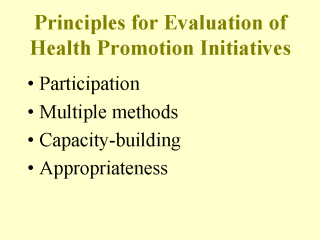| front |1 |2 |3 |4 |5 |6 |7 |8 |9 |10 |11 |12 |13 |14 |15 |16 |17 |18 |19 |20 |21 |22 |23 |24 |25 |26 |27 |28 |29 |review |
 |
- This often
poses a challenge to us in that sometimes the principles of scientific rigor and health
promotion are, or seem incompatible with each other as in the case where community
participation in the research process may put pressure on researchers to compromise
scientific rigor. - Although the Working Group did not offer an easy solution to this challenge, Ken Allison and I based on our experience as Co-Directors of the North York Community Health Promotion Research Unit (Allison and Rootman, 1986), suggested that attempts should be made to match the interests of researchers with the research priorities as expressed by the various levels of community, and community health promotion research requires greater investments in the time devoted to process issues. - Perhaps some of you have some additional suggestions to make to address this challenge and the more general challenge of defining what is meant by acceptable evidence in health promotion. Certainly, the work of the US Task Force on Community Preventive Services to develop criteria for categorizing the strength of a body of evidence on the effectiveness of a specific community intervention to impact on a given outcome is a useful contribution in this direction. - In any case, I would now like to move on the the issue of collating evidence on the effectiveness of health promotion. - As you may or may not be aware, this has recently become a growth industry in health promotion - I am aware of a number of such efforts including the following ones. |
| front |1 |2 |3 |4 |5 |6 |7 |8 |9 |10 |11 |12 |13 |14 |15 |16 |17 |18 |19 |20 |21 |22 |23 |24 |25 |26 |27 |28 |29 |review |